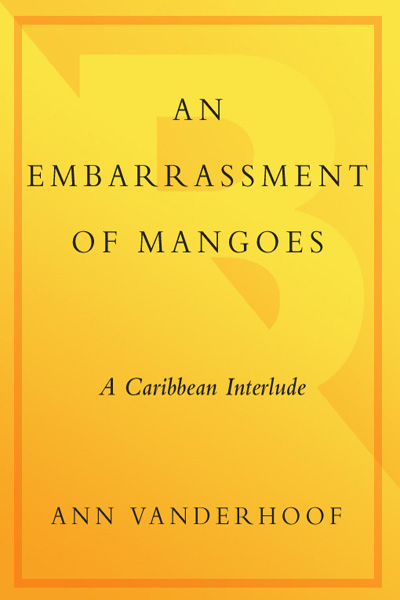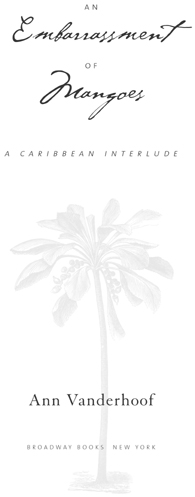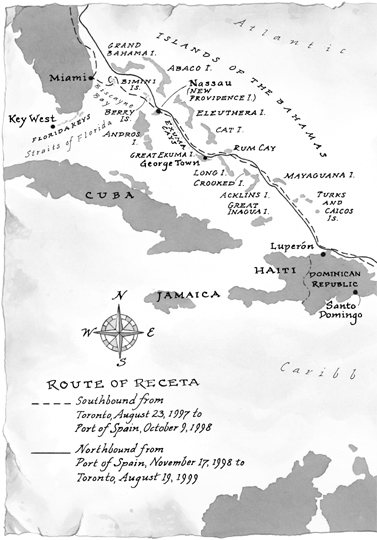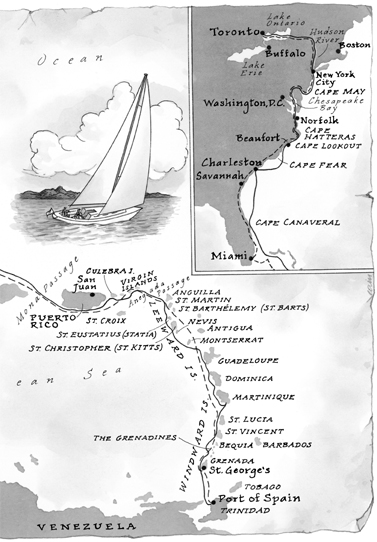An Embarrassment of Mangoes


Contents
Perry and Noel’s “Tastes Like Lobster” Conch
THE DELICIOUS DOMINICAN REPUBLIC
Cheesy Chicken with Avocado and Tomato Salsa
NOT QUITE SEASONED, BUT VERY WELL SALTED
Lower Woburn Stewed Lambi (Conch)
Traditional West Indian Recipe for Rum Punch
MR. BUTTERS, THE MYSTERIOUS BREADFRUIT, AND MONDAY NIGHT MAS
Pasta from Mr. Butters’s Garden
Stuffed Christophene au Gratin
Rum and Coconut Water à la
Receta
Curried Chicken in Coconut Milk with Island Vegetables
Sautéed Dorado with Creole Tomato Sauce
For Steve



As I write this, back in the real world, back in an office, back home, back up against a deadline, I glance down at the mousepad to my right, and I am filled once again with powerful longing. The pad is printed with a picture of a laughing woman stripping off a wetsuit on a golden beach. Her hair is streaked blond, her shoulders broad on an otherwise slender frame, muscular shoulders that look like they know how to work. She is completely relaxed, and radiates happiness. The slice of beach in the photo is deserted—pristine, private, no one and nothing on it, except for a pile of snorkeling gear in the sand at the woman’s feet. Behind her, the sea is turquoise glass, on which sits a lone boat with a white hull and a tall mast that has impaled the sky’s single puffy white cloud like cotton candy on a stick.
The woman does not appear to be looking at anyone, to even realize that her photo is being taken. She is just plain damn happy.
That woman is me.
Island Time
The market ladies sell spice necklaces—garlands of cloves, cinnamon bark, bay leaves, cocoa beans, mace, and nutmeg—that are irresistible. I now have them hanging all around the boat, making it smell spicy and delicious. Mangoes are in season, and literally falling off the trees—an embarrassment of mangoes, to someone from the north. We feel duty bound to try as many varieties as we can.
JOURNAL ENTRY, JULY 1998
In the distance, the hills on Hog Island are soft black silhouettes against a paler starlit sky the color of shark’s skin. Fish skip across the ocean surface in front of our small inflatable dinghy, each one a quick metallic sparkle in the beam of my flashlight. The air is heavy, warm, scented—partly a salty sea smell, from the shiny-wet rock wall close to us on one side, which has just been uncovered by the falling tide; but partly, too, the smell of lush land floating out from the dark hillsides, the fragrance of white frangipani and blooming spice trees.
Steve points our dinghy at the taller of the island’s rounded hills, and from my perch in the bow, I begin a slow, measured count, just loud enough for him to hear over the burble of the outboard: “Onnnnne Mississippi . . . twooooo Mississippi . . . threeeee Mississippi . . .” When I reach “tennnnnnn Mississippi,” Steve pulls the tiller to turn us toward the second, smaller hill, farther to the north. Within seconds now, if I’ve counted at the correct speed, my flashlight should pick up a pair of cantaloupe-sized white floats bobbing on the ocean ahead of us. About 20 feet apart, they mark a deep-water route that threads between patches of coral reef lying just below the surface. We had timed the turn during daylight, when the sea was serene and the sun high overhead, when we could clearly see the sapphire ribbon of safe water between the dappled yellow-green reefs.
“Slow it down,
slow it down
, I don’t see the floats yet,” I call back to Steve, panning my light nervously in wide arcs. We
have
to spot the floats before proceeding. If we don’t follow a line straight between them, we will almost certainly grind to a halt on the reef, damaging both it and our prop, and impaling the dinghy on the coral spikes—a far-from-appealing idea in a small rubber boat, in the darkness, on the ocean. He cuts the throttle.
We are heading home from dinner out with friends on the night of my forty-sixth birthday, and this thread-the-needle-in-the-dark dinghy trip is what heading home now involves. Because home these days is a 42-foot sailboat named
Receta
, which currently floats off the southeastern coast of Grenada, in a protected bay behind these shallow reefs. She has carried us to the Caribbean from Toronto, where we lived and worked until a year ago, and where we’ll return a year from now—2,100 miles south as the crow flies, but much,
much
farther as the sailboat travels.
“There. Got ’em.” The white balls gleam as I flick my light from one to the other so Steve can see the gap. We’re right on course. The anchorage opens up ahead, between a short finger of “mainland” Grenada on one side and a barely disconnected thumb of land, Hog Island, on the other. The masts of maybe twenty boats inscribe gentle arcs in the night sky, but I can pick
Receta
out from her neighbors by the
T
that glints near the top of her mast when I shine my light on it. I had placed that
T
there myself seven months earlier in Key Biscayne, Florida. Steve had winched me up the mast, and with both arms and both legs wrapped around it so tightly that the muscles ached for days afterward, I had peeled the backing off pieces of reflective tape and slapped them hurriedly on the metal, desperate to be lowered back down to sea level as quickly as possible. At the time, the reflective
T
was just an excuse to make the trip 50 feet above the water’s surface; the
real
reason was to prove to myself I could do it if I had to. At the time, it was still hard to imagine we would actually ever use the
T
to help us find our way home at night.
As the dinghy putts closer, Steve kills the engine so we glide the last few feet to
Receta
. The
slip-slap-slip-slap
of our wake on the hull dies away, and quiet seems to resettle on the darkness. In fact, the night is incredibly noisy—but the piping of thousands of tree frogs is by now an accustomed background sound, as ordinary and unremarkable a part of the summer night as the hum of an air conditioner once was. I grab the boat’s swim ladder, tie the dinghy to a cleat, and climb into the cockpit. We’re home.
A
bus comes hurtling around the curve past Nimrod’s rum shop every ten minutes or so, and while you wait you can watch Hugh Nimrod lettering a sign under the spreading ginnip tree next to the shop, his hands steady but his eyes a gentle haze of rum. If Hugh is inside serving a customer, there are always the goats to watch, the spindly young ones suckling on their mamas, who continue to graze intently up and down the roadside, pointedly ignoring the kids they drag along.
The morning is cool and green, the sun not yet risen high enough behind the mountains to feel its heat. It’s market day for us, and we have zipped across the turquoise bay in the opposite direction from last night and tied our dinghy to the long skinny dock at Lower Woburn—a village of a hundred or so people, a handful of tiny stores, a few chickens and goats, and a riotous profusion of banana, mango, coconut, breadfruit, and papaya trees. The local fishermen and lobster divers don’t bother with the dock; they just pull their heavy wooden boats up on the sliver of beach and run a line to a palm tree, leaving the dock free for kids to cannonball off the end or fish with their handlines, and for people like us to tether our dinghies when we come ashore.
A couple of minutes’ walk up the road from the dock brings us to Nimrod’s, where the bus stops—but, then again, the bus will stop almost anywhere along the winding road if you wave, or point, or scratch your nose, or slow your pace even a fraction, suggesting you just
might
be tempted into a ride. “Bus stop” is a flexible concept in Grenada, sensibly dictated by the driver’s bottom line, since public transit is privately, individually owned. You can get off most anywhere too, of course; just rap your knuckles on the metal frame of the bus when you’re ready.
The first bus to slide to a halt outside Nimrod’s this morning is named
All Eyes on We
—perfectly acceptable grammar on this island, where objective pronouns are scarce as snow. Like all its public-transit counterparts,
All Eyes on We
is a minivan, and the driver’s assistant—the conductor kid, we call him—throws open the side door for us to climb onboard. “Good morning,” Steve says immediately to the bus at large, loud enough to be heard over the high-volume soca tunes issuing from the van’s speakers. “Okaaayyyy,” “Good morning,” “Okay, okaaayyyyy,” the other passengers reply. People here are expected to say good morning and good afternoon to others on public transportation. To
strangers
. It’s simply good manners.
During the school year, the morning buses are jammed with kids in their neat uniforms. But today, in the row in front of me, one very little girl sits by herself, no older sibling sandwiched in next to her. Four years old at most, she sits quietly, looking straight ahead, very neatly turned out in a little red jumper and sporting a wonderful assortment of baubles in her elaborately braided hair: plastic cars, trains, planes, pumpkins, hearts, and balls, along with a rainbow of ribbons tied in careful bows. Without anyone signaling a stop, the bus pulls over about a mile down the road from Nimrod’s, in front of a church preschool. The teenage conductor kid—old enough to be packing an attitude—gently lifts the little girl down, helps her put on her tiny backpack, and then takes her by the hand and slowly walks her around the van to the path at the front of the church. From there, she skips off toward the building, a blur of red jumper and flying braids. The rest of the passengers wait patiently as this sweet, slow scene unfolds—no restlessness, no checking of watches, no mutterings about being late for morning appointments. On island time, it doesn’t matter. Most days, I don’t even bother to wear a watch.
Besides walking little girls to preschool, the conductor kid collects fares when passengers disembark and hands down their bags and packages. He also orchestrates the seating as the bus begins to get more crowded. Once every inch of the bench seats is occupied, he pulls down little tip-up seats that fill the aisle. The van is absolutely, completely full now, and I’m sure it won’t stop for anyone else. But no—someone gestures from the roadside, and now the conductor kid is a magician, whipping a cushion out of thin air and placing it over the gap between a tip-up seat and a bench seat to create a place for the new arrival to settle her ample self. Steve’s regular game on bus trips to town is to keep a running body count; the prize so far goes to the kid who managed to cram twenty-two bodies into a twelve-person van.
It’s perhaps only 5 straight-line miles from Nimrod’s to the center of St. George’s, Grenada’s capital, where the market is. But describing it as 5 straight-line miles doesn’t capture the essence of the half-hour trip: the ricocheting of the van through the curves, the driver beeping a firm “keep clear” to anyone who might be approaching from the other direction, since none of Grenada’s roads appears to be wider than one-and-three-quarters lanes. A wall of tropical vegetation rises up before us as we enter each hairpin turn, so thick I can feel its damp coolness on my face. Splashes of color jump out of the green—clusters of thimble-sized orange flowers on the flamboyant trees, and brilliant magenta bougainvillea. As we whip around the bends, I lurch into the unlucky women on either side of me, leaving a sticky sheen of perspiration on their cool, well-powdered skin.
Driving is a bit cavalier here. One Friday afternoon, our driver pulled to the side of the road across from a rickety one-room frame building that, like most every business along this road, is “licensed to sell spiritous liquors.” Without a word, the conductor kid trotted across the road, returning a minute later with a bottle of Royal Stout. The driver took a couple of grateful gulps and drove on. Nobody blinked.
The other evening, we heard on the news that anyone in Grenada who has more than thirty driving tickets is going to have his (or her, although we rarely see a woman behind the wheel) license suspended. That would be 3,000 Grenadians, the announcer said, set to lose their licenses. This, mind you, in a country where the number of driver’s licenses issued totals only about 18,500.
Finally, St. George’s opens up before us—gleaming white buildings with orange and red tile roofs arranged around a curve in the Caribbean Sea, the quintessential Caribbean capital. St. George’s is built into the island’s substantial hills, with the sea on one side of town and the protected harbor on the other. No one calls it the harbor, though. “Dey on deh Carenage,” you’ll be told if you ask directions to, say, police headquarters. “Deh Carenage” is where the big sailing ships were careened in centuries past—turned on their sides at low tide so their bottoms could be cleaned of barnacles, caulked, and repaired before they headed out to sea again, having exchanged the ballast of tiles they arrived with for cargoes of spices, coffee, fruit, and rum. Our bus teeters at the top of an impossibly steep street, until a white-gloved policeman gives the signal for the driver to descend toward the water.
“Mangoes. Look at my lovely mangoes.” “Christophene. Don’t you need christophene?” “Good morning, darlin’. Stop, take a look.” “My avocados deh best. Take a taste.” The bus disgorges us into a confusion of musical voices at the end of the route: the public market at the foot of Market Hill. Huge brightly colored umbrellas at rakish angles create pockets of shade amidst the hot white light. The tables underneath hold carefully arranged pyramids of tomatoes and limes, bundles of elephant ear–like callaloo leaves, brilliant orange wedges sliced from monstrous green-skinned pumpkins. On the ground are stalks of bananas and plantains in every stage of ripeness—fluorescent green to creamy yellow to almost solid black—and piles of mysterious, hairy, arthritic-looking roots.
The smell of spices is so strong I can taste them. Heaps of gnarled ginger overflow their trays and vie for table space with finger-long pieces of cinnamon and mauby bark tied in neat bundles, pungent allspice berries, sharp little cloves, glossy mahogany nutmegs, and broom-sized bunches of gray-green thyme. And everywhere,
everywhere
, the sweet perfume of mangoes hangs in the air. It’s mid-August, the last glorious gasp of mango season, and every market table groans with them. We’ve been devouring them greedily, a couple of times a day. Sometimes we do as we see the locals doing along the roadside, when they take a break from their work: cut slabs off the sides with a pocketknife, then pull the flesh from the skin with their teeth. But I also slice them and squirt them with lime for breakfast, turn them into salsas and salads, bake them into sweet crisps. With every mango I use, I stand over the sink and suck the last bits of sweetness off the flat seed, leaving fragrant, sticky trails of juice dripping off my chin. I have become a mango glutton, and I start to worry if my supply drops below half a dozen.
Today, I beetle toward one of my favorite market ladies, who does business from beneath an enormous lemon-yellow umbrella that came her way courtesy of Benson & Hedges. She’s resplendent in her stop-sign-red T-shirt and pants covered by a leopard-print apron, with a ball cap in the colors of the Grenadian flag—red, yellow, green—on her head. “Four for $4 EC, darlin’,” she says, pointing to the plump yellowy-orange mangoes stacked on her table. “What are they called?” I ask, because here, a mango is not simply a mango; at least half-a-dozen varieties are available in the market on any one day, and I’m trying to learn the differences. “Sealawn,” she says, drawing out the second syllable like a musical refrain, and the name seems fitting, since we’re surrounded by the sea and lush greenness. I know there’s a place called Seamoon toward the north end of the island; I envision the bountiful Sealawn right next to it, covered with heavily laden mango trees. “Sealawn,” I repeat as I load four into my backpack. She laughs her approval.